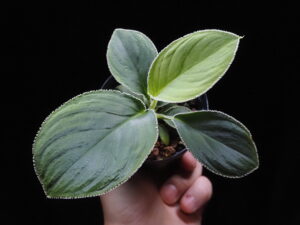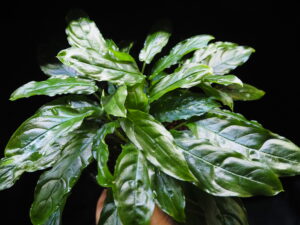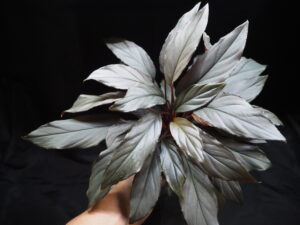Homalomena anthurioides Sumatera utara TB

It grows better if the entire flowerpot is hung.
Hanging the pot instead of placing it on a flat surface is a better way to grow Homalomena anthurioides. Due to its distinctive leaf shape, it is easy to grow by suspending the pot and allowing the leaves to naturally hang down, or by arranging it to attach to the wall of a terrarium.
When you first acquire this plant, it’s best to cultivate it in a Akadama soil alone. Once you see new root growth, you can switch to a nutrient-rich medium or provide fertilizer.
Since this species tends to dry out and die from the tips of its leaves when the humidity level drops, it’s essential to maintain a high humidity level. Adding moist moss to the surface of the soil can help retain moisture.
Generally, small jungle plants tend to grow larger in captivity than in the wild. Homalomena anthurioides is a unique species, so allowing it to grow to a larger size will showcase its distinctive features more prominently, which can be a fascinating sight.
Summary of officially published information
Studies on Homalomeneae (Araceae) of
Sumatera VI: Two remarkable new species of
Homalomena [Chamaecladon Clade] Homalomena anthurioides S.Y.Wong, P.C.Boyce & A.Hay 2020
ResearchGate , Journal of Plant Taxonomy and Geography , International Plant Names Index
The species name anthuroides is derived from the genus Anthurium, another type of Aroid, and is suffixed with the suffix “-oides”.
This suggests a particular similarity in the shape of the petiole with a terminal node, a common characteristic of the small vertical leaves of Anthurium.
However, this is a rare feature in Homalomena. It looks like a miniature Anthurium.
The leaf blade is very narrow and elliptic, folded at almost 90° to the petiole and sickle-shaped.
The flowers are pure white in the flowering period.
Homalomena anthuroides is currently known only from Type locality, where it is found in humid, shady, lowland jungle
This species is a bedrock-active species that grows in crevices in bedrock.
Because of its unique shape, it is highly ornamental and has already attracted the attention of horticultural collectors.
The exact information on the type locality is being withheld.











